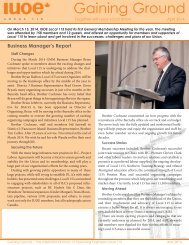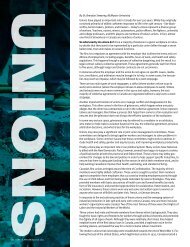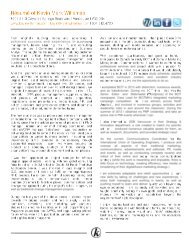OKANAGAN CRUSH PAD
You also want an ePaper? Increase the reach of your titles
YUMPU automatically turns print PDFs into web optimized ePapers that Google loves.
Magazine<br />
Most established wineries rely heavily on traditional print advertising to grow awareness of their brand. However, these ads are<br />
often generic and staid. OCP’s print advertisements are no different (see Appendix B-3).<br />
The ads are published with the intent to associate OCP with the Okanagan and establishing the OCP brand. The ads include the<br />
call to action to visit the website for more information, purchase online (as they can ship across Canada), or visit the store.<br />
The sans-serif typeface is effective as there is a small amount of copy; it is crisp and represents the modern brand. The earthy<br />
hues of the background image evoke serenity, warmth and peacefulness. However, the wine bottles, blend into the background<br />
and are lost, which they are supposed to be the focal point. This creates undue emphasis on the rosé bottle of wine. The<br />
campaign’s message is lost; there is no copy to communicate any brand benefits or product information. The elements in the ad<br />
do not speak to the targeted B2B audience. The ad doesn’t attract OCP’s secondary audience either, as it is positioned in an<br />
older, sophisticated drinker’s domain.<br />
Advertisements are placed in publications such as Wine Trails, Savour, and City Palate magazines. City Palate is a Calgarybased<br />
magazine; therefore including store hours in the copy may be irrelevant and wastes valuable space. OCP’s advertising in<br />
wine publications does not necessarily reflect any specific strategy, as winemakers are generally expected to advertise in large<br />
wine publications to maintain relationships with them. Therefore, no accurate, measurable success can be gauged from the ads’<br />
placement.<br />
Although the calls to action are sales oriented, the ad does not drive demand from retailers or end consumers, as no features or<br />
benefits are presented. It doesn’t represent OCP’s quirky and fun personality, but does communicate the relationship between<br />
OCP and the Okanagan.<br />
Online Advertising<br />
Online advertisements contain similar elements as the (above) magazine ads, with minor adjustments to layout and reduced<br />
copy to fit smaller, online areas.<br />
OCP has placed online advertisements on lifestyle and food interest websites, directed towards OCP’s secondary target market.<br />
For example, they have placed a banner ad on WineDiva.ca (see Appendix B-4), a Canadian wine blog, and a big box<br />
advertisement in a prime location on Scout Magazine’s homepage (see Appendix B-5). Urban Diner (see Appendix B-6), a wellknown<br />
community-style website about local Vancouver cuisine, also features a collage of online ads, including OCP. Both<br />
public consumers and restaurants would also visit Urban Diner’s website, as they feature blogs on new up-and-coming<br />
restaurants.<br />
Clicking on an OCP ad directs the viewer to the OCP website. The fact they are featured on the websites for an extended period<br />
(2-3 months) suggests increased impressions and frequency. Research has shown that “repeated exposure to a product via<br />
banner ads generate a positive feeling towards that product” (Baker, 2012). Therefore, exposing OCP wines on the<br />
advertisements will create a positive position among the minds of those who influence the retailers and restaurants within<br />
OCP’s target market. Scout Magazine and Urban Diner ads are placed on the right hand side of the webpage, above the fold,<br />
retrieving a reported average viewership of 74% (Fox, 2012). However, Wine Diva places the OCP banner below the fold of the<br />
blog; according to Mashable.com, this creates less exposure, receiving an average viewership of just 33%.<br />
While the ads are attractive, they are not original or extremely noticeable. The websites advertising OCP are not very well<br />
established and do not align fully with a similar OCP persona.<br />
Public Relations<br />
Wine producers are heavily dependent on professional publications and influencer opinions to grow awareness and trialing of<br />
their products. Winemakers are “expected” to support the industry by advertising, hosting media events, and attending<br />
exhibitions. In return, the media covers the events quite extensively.<br />
LOGICAL ART Page | 8


















